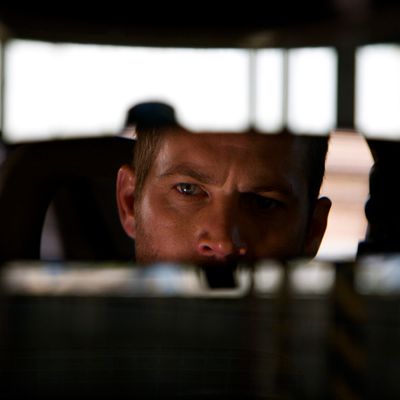
Please hold your laughter, briefly, while I sing the praises of one Paul Walker.
Seriously, stop giggling. Yes, Walker isn’t exactly much praised for his acting skills. But he also, I think, understands his limitations: For the most part, he knows to always play the seemingly ordinary guy out of his element. Even the Fast and Furious films use him as a straight man. The much-commented-on diversity of that franchise has been built partly around the basic blankness of his character: He doesn’t do much, so the rest of the crew takes the spotlight.
In the meantime, as the blandly handsome dude in way over his head, Walker has given some terrific performances in some seriously underrated films: 2001’s gearhead horror flick Joy Ride, for example, or 2006’s gonzo cop thriller Running Scared. In those films, he’s perfect as a kind of likable, not-too-bright guy who you hope will do well, but who’ll probably screw everything up. Think a more whitebread version of Keanu Reeves — but without that weird, haunted quality that launched Keanu into the stratosphere. (Walker does a superior variation on Point Break’s Johnny Utah in the original Fast and the Furious, but you could never imagine him pulling off Neo from The Matrix.)
Paul Walker, in other words, is a whiter, better-looking version of us. That’s his thing, and he knows it.
Which brings us to Vehicle 19. It seems determined to capitalize on Walker’s success in the Fast and Furious films by once again putting him behind the wheel of a car that’s being tormented by various baddies, some of them in other cars. Here, our hero is Michael Woods (a proper Paul Walker name, right up there with Brian O’Conner or Lewis Thomas or Chris Johnston), who arrives in South Africa and picks up a rental car, only to discover that it’s the wrong vehicle: This one has a gun and a phone in it, and, as he later discovers, a woman tied up in the trunk (Rachel Shabangu). She’s a journalist who has uncovered a vast human trafficking conspiracy that reaches up all the way to the chief of police. At first, Michael is reluctant to try to help the woman; he actually just got out of prison himself, he’s trying to reconcile with his ex-wife, and he doesn’t want to screw his life up any further. But the situation forces his hand.
That’s not a particularly original setup, but writer-director Mukunda Michael Dewil (who has the coolest director name this side of Fridrik Thor Fridriksson) has a couple of solid tricks up his sleeve. For starters, the camera never leaves the car, which means that it’s waiting there before Michael even steps inside, and it seems to keep him there over the course of the film; it’s not just a camera, it’s a force of destiny. This is also an excellent gimmick for shooting car chases, and a far cry from the gloriously ridiculous CGI theatrics of the Fast and Furious films. The cars crashing into supermarket shelves or somersaulting across the road or whatever have real weight to them this time around. But there’s also a dreamlike quality to these scenes — both because we never quite see the whole picture and also because we’re safely tucked away behind the windshield.
But to make an idea like this work to its full potential, you need a pretty strong visual stylist ± which Dewil is not, unfortunately. The car chases might be great, but whenever the actual plot kicks in, we get fairly drab, repetitive shots of a bewildered Walker trying to process what’s going on around him — the stranger he’s found in his car, a threatening voice on the other end of the phone, the occasional South African (usually black, usually poor) who intrudes on his automotive space. Walker isn’t too bad at looking frustrated; as discussed, it’s his forte. But we rarely get a feel for what’s going on inside this car: Dewil is good at looking out the windshield, but seems to falter when he has to actually look at his characters and focus on the drama he’s created. The film conveys information in only the broadest strokes possible: The revelation of the alleged sex-trafficking ring is confined to just a few sentences, and the back-and-forth between Michael and the journalist never gets to the level of one person convincing the other. In a big, dumb action movie, maybe this sort of thing wouldn’t have mattered. But here, in an ostensibly more serious, focused work, it’s a fatal miscalculation. Vehicle 19 sets up a fascinating conceit for itself, and then loses interest in delivering on it. It just wants to get to the cool car chase, but by the time it does, we’ve stopped caring.


